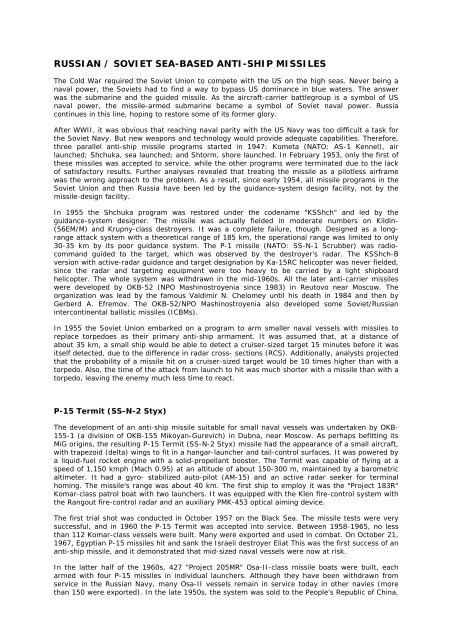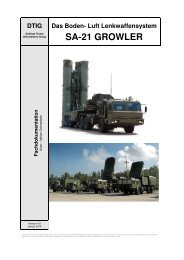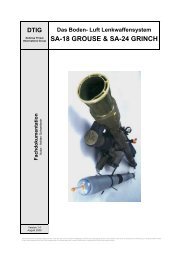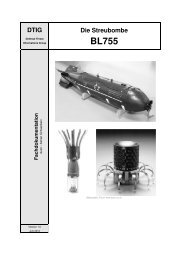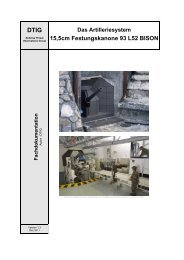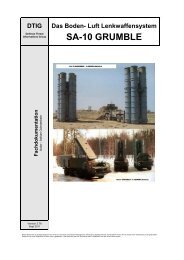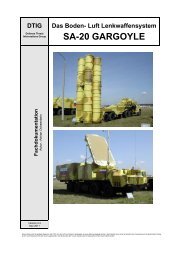RUSSIAN/SOVIET SEA-BASED ANTI-SHIP MISSILES Specia ... - DTIG
RUSSIAN/SOVIET SEA-BASED ANTI-SHIP MISSILES Specia ... - DTIG
RUSSIAN/SOVIET SEA-BASED ANTI-SHIP MISSILES Specia ... - DTIG
Create successful ePaper yourself
Turn your PDF publications into a flip-book with our unique Google optimized e-Paper software.
<strong>RUSSIAN</strong> / <strong>SOVIET</strong> <strong>SEA</strong>-<strong>BASED</strong> <strong>ANTI</strong>-<strong>SHIP</strong> <strong>MISSILES</strong><br />
The Cold War required the Soviet Union to compete with the US on the high seas. Never being a<br />
naval power, the Soviets had to find a way to bypass US dominance in blue waters. The answer<br />
was the submarine and the guided missile. As the aircraft-carrier battlegroup is a symbol of US<br />
naval power, the missile-armed submarine became a symbol of Soviet naval power. Russia<br />
continues in this line, hoping to restore some of its former glory.<br />
After WWII, it was obvious that reaching naval parity with the US Navy was too difficult a task for<br />
the Soviet Navy. But new weapons and technology would provide adequate capabilities. Therefore,<br />
three parallel anti-ship missile programs started in 1947: Kometa (NATO: AS-1 Kennel), air<br />
launched; Shchuka, sea launched; and Shtorm, shore launched. In February 1953, only the first of<br />
these missiles was accepted to service, while the other programs were terminated due to the lack<br />
of satisfactory results. Further analyses revealed that treating the missile as a pilotless airframe<br />
was the wrong approach to the problem. As a result, since early 1954, all missile programs in the<br />
Soviet Union and then Russia have been led by the guidance-system design facility, not by the<br />
missile-design facility.<br />
In 1955 the Shchuka program was restored under the codename "KSShch" and led by the<br />
guidance-system designer. The missile was actually fielded in moderate numbers on Kildin-<br />
(56EM/M) and Krupny-class destroyers. It was a complete failure, though. Designed as a longrange<br />
attack system with a theoretical range of 185 km, the operational range was limited to only<br />
30-35 km by its poor guidance system. The P-1 missile (NATO: SS-N-1 Scrubber) was radiocommand<br />
guided to the target, which was observed by the destroyer's radar. The KSShch-B<br />
version with active-radar guidance and target designation by Ka-15RC helicopter was never fielded,<br />
since the radar and targeting equipment were too heavy to be carried by a light shipboard<br />
helicopter. The whole system was withdrawn in the mid-1960s. All the later anti-carrier missiles<br />
were developed by OKB-52 (NPO Mashinostroyenia since 1983) in Reutovo near Moscow. The<br />
organization was lead by the famous Valdimir N. Chelomey until his death in 1984 and then by<br />
Gerberd A. Efremov. The OKB-52/NPO Mashinostroyenia also developed some Soviet/Russian<br />
intercontinental ballistic missiles (ICBMs).<br />
In 1955 the Soviet Union embarked on a program to arm smaller naval vessels with missiles to<br />
replace torpedoes as their primary anti-ship armament. It was assumed that, at a distance of<br />
about 35 km, a small ship would be able to detect a cruiser-sized target 15 minutes before it was<br />
itself detected, due to the difference in radar cross- sections (RCS). Additionally, analysts projected<br />
that the probability of a missile hit on a cruiser-sized target would be 10 times higher than with a<br />
torpedo. Also, the time of the attack from launch to hit was much shorter with a missile than with a<br />
torpedo, leaving the enemy much less time to react.<br />
P-15 Termit (SS-N-2 Styx)<br />
The development of an anti-ship missile suitable for small naval vessels was undertaken by OKB-<br />
155-1 (a division of OKB-155 Mikoyan-Gurevich) in Dubna, near Moscow. As perhaps befitting its<br />
MiG origins, the resulting P-15 Termit (SS-N-2 Styx) missile had the appearance of a small aircraft,<br />
with trapezoid (delta) wings to fit in a hangar-launcher and tail-control surfaces. It was powered by<br />
a liquid-fuel rocket engine with a solid-propellant booster. The Termit was capable of flying at a<br />
speed of 1,150 kmph (Mach 0.95) at an altitude of about 150-300 m, maintained by a barometric<br />
altimeter. It had a gyro- stabilized auto-pilot (AM-15) and an active radar seeker for terminal<br />
homing. The missile's range was about 40 km. The first ship to employ it was the "Project 183R"<br />
Komar-class patrol boat with two launchers. It was equipped with the Klen fire-control system with<br />
the Rangout fire-control radar and an auxiliary PMK-453 optical aiming device.<br />
The first trial shot was conducted in October 1957 on the Black Sea. The missile tests were very<br />
successful, and in 1960 the P-15 Termit was accepted into service. Between 1958-1965, no less<br />
than 112 Komar-class vessels were built. Many were exported and used in combat. On October 21,<br />
1967, Egyptian P-15 missiles hit and sank the Israeli destroyer Eliat This was the first success of an<br />
anti-ship missile, and it demonstrated that mid-sized naval vessels were now at risk.<br />
In the latter half of the 1960s, 427 "Project 205MR" Osa-II-class missile boats were built, each<br />
armed with four P-15 missiles in individual launchers. Although they have been withdrawn from<br />
service in the Russian Navy, many Osa-II vessels remain in service today in other navies (more<br />
than 150 were exported). In the late 1950s, the system was sold to the People's Republic of China,


